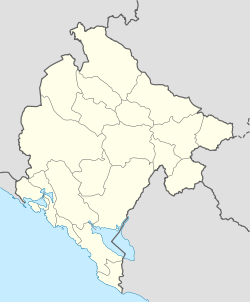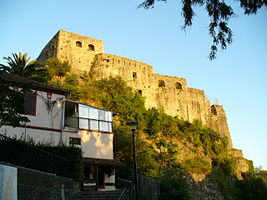- Herceg Novi
-
Herceg Novi 
Coat of armsLocation of Herceg Novi in Montenegro Coordinates: 42°27′10.62″N 18°31′52.33″E / 42.45295°N 18.5312028°ECoordinates: 42°27′10.62″N 18°31′52.33″E / 42.45295°N 18.5312028°E Country  Montenegro
MontenegroFounded 1382 Settlements 27 Government – Mayor Dejan Mandić (SNP) – Ruling party SNP - SL - PP Area – Total 235 km2 (90.7 sq mi) Population (2003 census) – Total 12,739 – Density 140/km2 (362.6/sq mi) – Municipality 33,034 Time zone CET (UTC+1) – Summer (DST) CEST (UTC+2) Postal code 85340 Area code +382 31 ISO 3166-2 code ME-08 Car plates HN Website www.herceg-novi.me Herceg Novi (Serbian Cyrillic: Херцег Нови; pronounced [xě̞rt͡se̞g nɔ̝̂v̞iː]; Italian: Castelnuovo; Greek: Νεοκαστρον, Neòkastron) is a coastal town in Montenegro located at the entrance to the Bay of Kotor and at the foot of Mount Orjen. It is the administrative center of the Herceg Novi Municipality with around 33,000 inhabitants. Herceg Novi was known as Castelnuovo ("New castle" in Italian) between 1420 and 1797 when was part of the Albania Veneta of the Republic of Venice. Herceg Novi has had a turbulent past, despite being one of the youngest settlements on the Adriatic. A history of varied occupations has created a blend of diverse and picturesque architectural style in the city.[1] The City Administration is formed by a coalition of the SNP, SNS, NS and DSS political parties.
Contents
History
Herceg Novi was founded (on a former small fishing village existing since Roman Empire times) as a fortress in 1382 by Bosnian King Stjepan Tvrtko I and was called Sveti Stefan or Castelnuovo. After the death of Tvrtko, Duke Sandalj Hranić of the Herzegovinian Kosačas acquired Castelnuovo. During his reign, Herceg Novi picked up trading salt. When Hranić died, his nephew, Herzog Stjepan Vukčić Kosača, inherited Castelnuovo. Under Stjepan, Castelnuovo expanded and thus became a city, renaming it to Herceg Novi. The Turks conquered Herceg Novi in 1482, and ruled for 200 years, until 1687. However, there was a short pause between 1538 and 1539 when it was overtaken by the Spaniards.
Venice gained control of the city and organised it into one administrative unit called Albania Veneta, along with the Bay of Kotor (then called "Bocche di Cattaro") and present-day coastal Montenegro. On 24 August 1798, Herceg Novi was annexed by Austria but was then ceded to Russia as per the Treaty of Pressburg on 26 December 1805. The Russians officially occupied Herceg Novi between 28 February 1806 and 12 August 1807.
On 7 July 1807, Herceg Novi was ceded to France as per the Treaty of Tilsit. Official French rule over Herceg Novi began on 12 August 1807, when the Russians left the city. The city was part of Dalmatia until 14 October 1809, when it was annexed to the newly-created Illyrian Provinces.
Herceg Novi, as well as the rest of the Bay of Kotor, was overtaken by Montenegrin forces in 1813. It was under control of a temporary government based in Dobrota between 11 September 1813 and 10 June 1814, which was supported by Montenegro. The appearance of Austro-Hungarian forces in 1814 caused the Prince-Bishop of Montenegro to turn over the territory to Austrian administration on June 11.
After Herceg Novi was retaken, as well as the rest of the bay, it became part of the Dalmatian crownland. The bay was under Austro-Hungarian control until 1918.
The Kingdom of Montenegro attempted to retake the Bay of Kotor during World War I, it was bombarded from Lovćen, but by 1916 Austria-Hungary defeated Montenegro. On 7 November 1918, the Serbian Army entered the bay and were greeted by the people as liberators. The bay later became a part of the self-proclaimed State of Slovenes, Croats and Serbs, although expressed for a direct union with Serbia rather. Within a month, the Kingdom of Serbs, Croats and Slovenes was formed, renamed to Yugoslavia in 1929. The bay was a municipality of Dalmatia until it was, like all historic entities, abolished in 1922. It was incorporated into the Zeta Oblast, from 1929 Zeta Banate.
Herceg Novi was annexed by the Italians during World War II in 1941. It became a part of the province of Cattaro. Herceg Novi was later retaken by Yugoslav Partisan forces on 10 September 1943. Herceg Novi was later officially annexed to Yugoslavia as part of the People's Republic of Montenegro.
Population
The Herceg Novi municipality stretches from Prevlaka to the Verige strait. An almost unbroken string of towns lie along this strip of coast, accommodating the municipality's 33,034 (2003 census) residents. These include Igalo, Herceg Novi, Baošići, Đenovići, Meljine and Bijela. Due to their proximity, Herceg Novi and Igalo are usually considered one town with a combined population of 16,493. Administratively, Herceg Novi's current population is 12,739.
Population of Herceg Novi town proper including Igalo:
- November 1, 2003–16,493
- March 3, 1991 - 15,105
- March 3, 1981 - 12,686
Ethnic groups—Current
2003 census, total of 33,971:
- 17,818 Serbs (52.45%)
- 9,651 Montenegrins (28.41%)
- 831 Croat (2.45%)
- 290 Romas (0.85%)
- 218 Muslims (0.64%)
- 89 Bosniaks (0.26%)
- 25 Albanians (0.07%)
- 1,350 others (3.97%)
- 2,800 undeclared (8.24%)
- 899 unknown (2.65%)
Ethnic groups—Historic
1991 census, total of 27,589:
- 11,223 Montenegrins (40.67%)
- 8,528 Serbs (30.91%)
- 5,257 Yugoslavs (19.05%)
- 630 Croats (2.28%)
- 332 Muslims (1.2%)
- 103 Albanians (0.37%)
- 1,516 others (5.52%)
1981 census, total of 23,258:
- 9,877 Montenegrins (42.46%)
- 8,006 Yugoslavs (34.42%)
- 3,844 Serbs (16.52%)
- 702 Croats (3.01%)
- 152 Muslims (0.65%)
- 83 Albanians (0.35%)
- 594 others (2.59%)
1971 census, total of 18,368:
- 8,581 Montenegrin (46.71%)
- 5,216 Serbs (28.39%)
- 2,553 Yugoslavs (13.89%)
- 1,195 Croats (6.5%)
- 83 Albanians (0.45%)
- 82 Muslims (0.44%)
- 658 others (3.62%)
1961 census, total of 15,157:
- 8,849 Montenegrins (58.38%)
- 4,261 Serb (28.11%)
- 1,544 Croats (10.18%)
- 102 Yugoslavs (0.67%)
- 67 Albanians (0.44%)
- 31 Muslim (0.2%)
- 303 others (2.02%)
1948 census:
- 73.02% Montenegrins and others
- 18.59% Serbs
- 8.39% Croats
Tourism
Herceg Novi is a major Montenegrin tourist destination. It is well known as a spa and health center; nearby Igalo has an abundance of healing sea mud called "igaljsko blato" (Igalo mud) and mineral water springs called "igaljske slatine" (Igalo water springs). The most famous tourist attractions in Herceg Novi are castle Forte Mare built by the Bosnian king Tvrtko I in 1382, a clock tower built by Austrians in 19th century, the Kanli tower built by Turks, and the Serbian church St. Michael Archangel in central Belavista Square.
Whilst the city itself is not a major destination for sunbathing, with no long sandy beaches along the rest of the Boka Kotorska bay, many beaches are reachable by boat. Tourist companies organise one-day boat trips to Luštica peninsula, which lies opposite to the town. Popular Luštica peninsula beach sites include Žanjic, Mirište and Rose. Herceg Novi accounted for one-third of overnight stays in Montenegro before the Yugoslav wars, but the situation has changed since in favour of Budva, Kotor and other resorts in the northern part of the coast.
Culture
"JUK Herceg-Fest"
This cultural events center was established on February 24, 1992. Two years later the cultural center joined with the "Orijen" movie distribution and production company. Together they have played a crucial role in enhancing the city's cultural life. Among many annual festivities are the mimosa celebration, local theatrical events, and a film and music fest.
The Herceg Novi City Archive
In 1956 the Archive was returned to Herceg Novi after being temporarily relocated to Zadar, Croatia. The Archive was relocated to Zadar by Italians during the Second World War. The original archive building, built in 1885, suffered severe damage from the 1979 earthquake. Shortly afterward, the building was renovated. Today, the Archive is 700 m² in size. The Archive features modern equipment and a library open to the public. The oldest document in the Archive originated in 1685. The library contains approximately 30,000 volumes and 1,000 periodicals.
Historical Museum
The museum was established in 1949 and officially opened in 1953. The museum building, a gift to the city from the former mayor, Mirko Komnenović (1870–1941), and his wife Olga, is at least 150 years old.
City library
The library contains at least 30,000 volumes. Among the contributors to this collection are Dušan Petković (5,000 books), Veljka Radojević (1,500), Doklestić, Daljev, Lučić, Subotić and others.
Transport
Herceg Novi is usually the final destination of buses that come from inland Montenegro and Serbia. The Adriatic Motorway, a two-lane motorway that extends for the length of the Montenegrin coast, goes through Herceg-Novi before it merges with the Croatian road network at the Debeli Brijeg border crossing.
The ferry operates on the Kamenari - Lepetane line at Verige Strait, eliminating the need to go all the way around Boka Kotorska bay in order to reach Tivat, Kotor, Budva and inland Montenegro.
Tivat Airport is 23 km (14 mi) away (via the ferry). There are regular flights to Belgrade and Zurich, and dozens of charter planes land daily on Tivat airport during the summer season. Dubrovnik Airport in Croatia is some 30 km (19 mi) away, and it maintains regular flights to many Europenan destinations.
Climate
The area of the Bay of Kotor is characterized by a Mediterranean climate with dry and hot summers and warm winters. Herceg Novi has a specific microclimate, which is a result of southern exposition, proximity to the sea, limestone substratum and mountainous hinterland which prevents the breakthrough of cold air masses.
Herceg Novi has approximately 200 sunny days a year. In July and August there are approximately 11 sunny hours per day. Average annual temperature is 16.2 °C (61.2 °F) (similar to that of Naples and Lisbon). There are frequent slight temperature oscillations; the average daily temperature fluctuation is only 4 °C (39 °F). Average temperature from May to September is about 25 °C (77 °F), which provides a swimming season over 5 months long since the average summer sea temperature is rather high, between 22 °C (72 °F) - 26 °C (79 °F).
The annual average precipitation is 1,930 millimetres (76 in). Relative air humidity is at its highest level, 80%, in the fall. Its lowest level, 63%, comes in the summer.
Gallery
-
Herceg Novi from the Adriatic Sea
International relations
Twin towns — Sister cities
 Guglionesi, Italy
Guglionesi, Italy Smederevo, Serbia
Smederevo, Serbia Zemun, Serbia
Zemun, Serbia Levanger, Norway
Levanger, Norway Kranj, Slovenia
Kranj, Slovenia Bitola, Macedonia
Bitola, Macedonia
References
External links
- Official website of Herceg Novi municipality
- City Port Herceg Novi
- City Guide of Herceg Novi
- Herceg-Novi - a city that you miss... (video)
- Herceg Novi Art
- Museum and Gallery Herceg Novi - Official web site
- Museum and Gallery Herceg Novi News
- Rastko-Boka Foundation
- Herceg Novi web site
- Photos from Herceg Novi at Fotokate.pl/
- Jeff Shanberg's photos from Herceg Novi
- Herceg Novi - Levanger: Twin municipalities
- Herceg Novi Photos
- Herceg Novi Old Town Map
Categories:- Populated places in Montenegro
- Herceg Novi
Wikimedia Foundation. 2010.
















